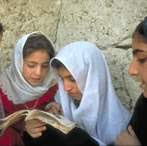 By: Kalsum Khan
By: Kalsum Khan(Killa Saifullah): Amna, Qudsia and Areeba look no different to other Pakistani schoolgirls. The trio of nine-year-olds with neatly braided hair and pressed uniforms giggle at a private joke as they walk through the gates of their school in the town of Sibi in Balochistan Province.
However, in the context of Balochistan, Pakistan's least developed province, they are unusual: they are among the very few girls who go to school.
Balochistan's female literacy rates are among the lowest in the world, with most girls not enrolled in a school. The province's literacy level - 37 percent - lags behind that of Pakistan's three other provinces and the national average of 53 percent.
Analyst Syed Fazl-e-Haider, a columnist with the Dawn English weekly newspaper based in the capital, Islamabad, estimated last month that the rural literacy rate in the province stood at no more than 23 percent.
The literacy rate for Balochistan's women was estimated at 20 percent, with only 10 percent of rural women receiving schooling.The Society for Community Support for Primary Education in Balochistan, an NGO, estimated that the female literacy rate in rural Balochistan increased from only 1.5 percent in 1992 to 8.9 percent in 1998.
"Some districts in Balochistan have among the lowest enrolment and literacy rates in the world, with one district recording only two percent enrolment at the primary [school] level," Naveed Hassan Naqvi, a World Bank education economist who also heads the Balochistan education support project, said.
The project has helped provide a US $22 million loan to set up community schools targeting girls.
But observers said there were numerous challenges to bringing the province level with other parts of Pakistan. Social attitudes were a problem but the ongoing conflict between the Pakistani military and local tribes was also detrimental.
The Human Rights Commission of Pakistan (HRCP) said fighting that flared in the Dera Bugti and Kohlu districts southeast of the province's capital, Quetta, late last year had killed at least 300 and forced thousands to flee. Children's education had been disrupted for at least six months. The fighting had eased but many families had yet to return.
"We moved to Sibi eight years ago from our village in the Dera Bugti district because there were no schools there and we wanted our children to be educated," Akbar Ahmed, 34, whose three children attend school in the town, said.
Elsewhere, law and order issues provided more problems. HRCP said there had been increased reports of highway robbery, vehicle theft and kidnapping.
Pakistan's government blames feudal leaders for the province’s backwardness.
"Feudal chiefs who hold back development for their own purposes will not be tolerated," Pakistan's President Pervez Musharraf said recently.
However, many people in Balochistan believe the issue is more complex. They blame the lack of development and extreme poverty on the authorities and accuse them of failing to grant the province control over its considerable natural resources. Balochistan contains 90 percent of the country's natural gas.
However, in the context of Balochistan, Pakistan's least developed province, they are unusual: they are among the very few girls who go to school.
Balochistan's female literacy rates are among the lowest in the world, with most girls not enrolled in a school. The province's literacy level - 37 percent - lags behind that of Pakistan's three other provinces and the national average of 53 percent.
Analyst Syed Fazl-e-Haider, a columnist with the Dawn English weekly newspaper based in the capital, Islamabad, estimated last month that the rural literacy rate in the province stood at no more than 23 percent.
The literacy rate for Balochistan's women was estimated at 20 percent, with only 10 percent of rural women receiving schooling.The Society for Community Support for Primary Education in Balochistan, an NGO, estimated that the female literacy rate in rural Balochistan increased from only 1.5 percent in 1992 to 8.9 percent in 1998.
"Some districts in Balochistan have among the lowest enrolment and literacy rates in the world, with one district recording only two percent enrolment at the primary [school] level," Naveed Hassan Naqvi, a World Bank education economist who also heads the Balochistan education support project, said.
The project has helped provide a US $22 million loan to set up community schools targeting girls.
But observers said there were numerous challenges to bringing the province level with other parts of Pakistan. Social attitudes were a problem but the ongoing conflict between the Pakistani military and local tribes was also detrimental.
The Human Rights Commission of Pakistan (HRCP) said fighting that flared in the Dera Bugti and Kohlu districts southeast of the province's capital, Quetta, late last year had killed at least 300 and forced thousands to flee. Children's education had been disrupted for at least six months. The fighting had eased but many families had yet to return.
"We moved to Sibi eight years ago from our village in the Dera Bugti district because there were no schools there and we wanted our children to be educated," Akbar Ahmed, 34, whose three children attend school in the town, said.
Elsewhere, law and order issues provided more problems. HRCP said there had been increased reports of highway robbery, vehicle theft and kidnapping.
Pakistan's government blames feudal leaders for the province’s backwardness.
"Feudal chiefs who hold back development for their own purposes will not be tolerated," Pakistan's President Pervez Musharraf said recently.
However, many people in Balochistan believe the issue is more complex. They blame the lack of development and extreme poverty on the authorities and accuse them of failing to grant the province control over its considerable natural resources. Balochistan contains 90 percent of the country's natural gas.


